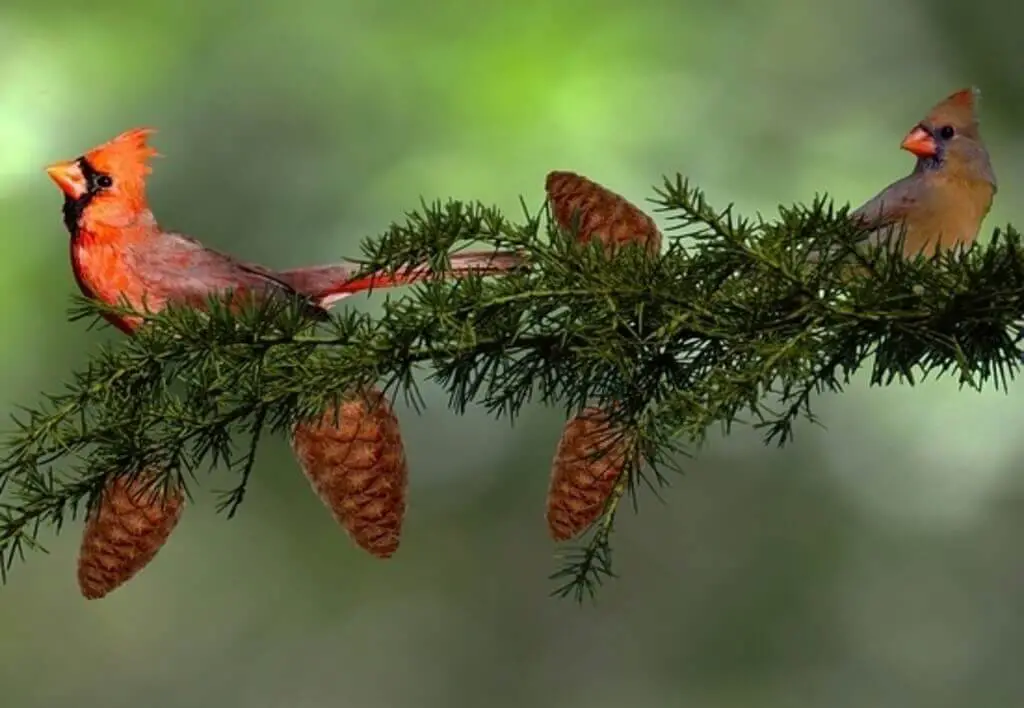Step into the captivating realm of avian cuisine, where pine cones transform into unexpected delicacies. Join us on a journey through “12 Birds That Eat Pine Cones,” as we explore the intriguing world of diverse bird species and their remarkable strategies for extracting nourishment from these woody treasures.
From lush forests to tranquil woodlands, we’ll delve into the habitats, behaviors, and unique adaptations that allow these feathered connoisseurs to savor the flavors of nature’s arboreal offerings.
Table of Contents
Types of Birds That Eat Pine Cones
Northern Cardinal
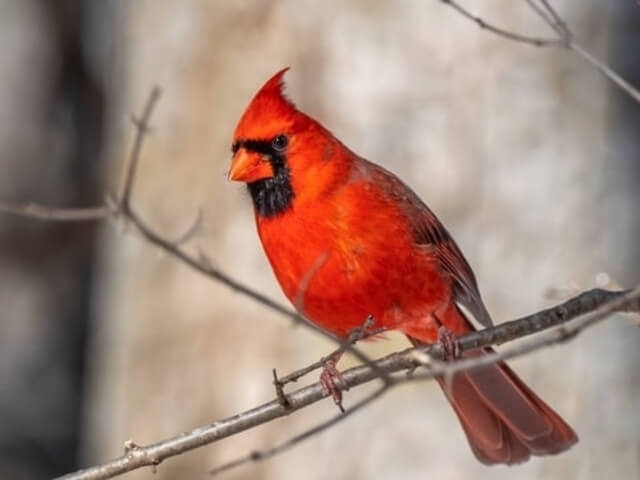
The Northern Cardinal is a songbird native to North America. They can be found throughout Canada, United States, and Mexico. Cardinals eat pine cones from trees that they feed on during their breeding season in late winter or early spring.
The more coniferous trees in your area, the better chance you have of seeing a cardinal at some point during winter because it’s not often that there are many insects around for them to feed on. Pine cones can be found year-round, but they’re most plentiful from September through November, when they drop off of tree branches.
House Sparrow

House sparrows, a widespread bird species, inhabit both the Eastern and Western United States, extending their range from North Carolina to Canada. They also venture into Central America and northern South America.
These adaptable birds frequently grace bird feeders, lured by seed blends that include sunflower seeds, fruits, insects, and other small creatures like spiders and earthworms. Among their preferred treats are pine cone seeds, which they source from trees or glean by skillfully opening cones found on the ground.
Tufted Titmouse
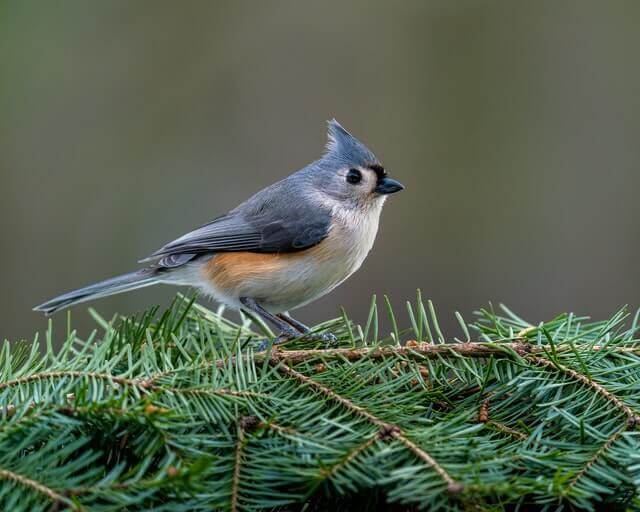
The Tufted Titmouse is a small songbird found in the United States and Canada. They are often seen foraging on or near the ground, but will occasionally perch high up in trees as well. The Tufted Titmouse eats seeds from many types of plants including pine cones which they break open with their strong beaks to eat the kernel inside.
The range of this bird extends across most of North America, including all areas east of the Rocky Mountains except parts of the southwestern United States and the southeastern coast. It is also found in Central America, Mexico, and parts of northern South America (eastern Colombia, eastern Ecuador, Venezuela).
Black-capped Chickadee
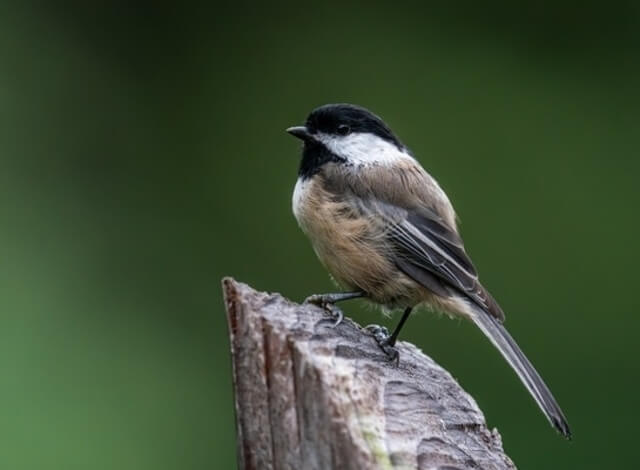
The Black-capped Chickadee, a widespread avian resident of North America, predominantly inhabits regions spanning Canada, Alaska, and the United States, excluding Hawaii. Its adaptable nature allows it to thrive in diverse environments, from suburban yards to dense forests and even mountaintops.
These charming birds maintain a flexible diet, primarily comprising insects and seeds, including pine cone seeds. However, during their southward migration in the fall, when fruits and berries become scarce, they readily indulge in these seasonal treats. This dietary versatility reflects their ability to adapt to changing food sources throughout the year.
Mountain Chickadee

The Mountain Chickadee is a common bird found in the eastern United States. It ranges from northern Maine to Nebraska and down into Florida, where it’s replaced by the Carolina Chickadee. The habitats for this species are typically deciduous forests with scattered trees or open areas, including suburbs with large shade trees.
They can also be found at higher elevations, up to around 8500 feet above sea level. Their diet consists mostly of insects, fruit, nuts, seeds and berries. They are seen during the day searching for food, but usually come out at dusk to search for any nighttime sources of sustenance they can find, including tree sap or pine cone seeds.
Red Crossbill

The Red Crossbill is a type of finch that is found in North America. They are found in Eastern Canada and Western United States. The range can be anywhere from Newfoundland to California, with the majority of their population living in the Rocky Mountains region.
They live primarily in coniferous forests or mixed forest-coniferous habitats, where they have access to both pine cones and various types of berries. They feed on insects such as ants and beetles, or seeds like sunflower seeds or pine cone seeds (more commonly found in birds’ diets).
Pine Grosbeak

The Pine Grosbeak, a sizable finch native to North America, calls a diverse range of habitats home, spanning from Canada through the eastern United States and into Mexico. While they typically inhabit coniferous forests, these adaptable birds also establish nests in proximity to open areas adorned with scattered trees or shrubs, particularly where food sources abound.
Pine Grosbeaks boast a versatile diet that encompasses insects, berries, nuts, and, during the winter months when their conventional food sources become scarce, they turn to pine cone seeds to sustain themselves.
Pine Siskin
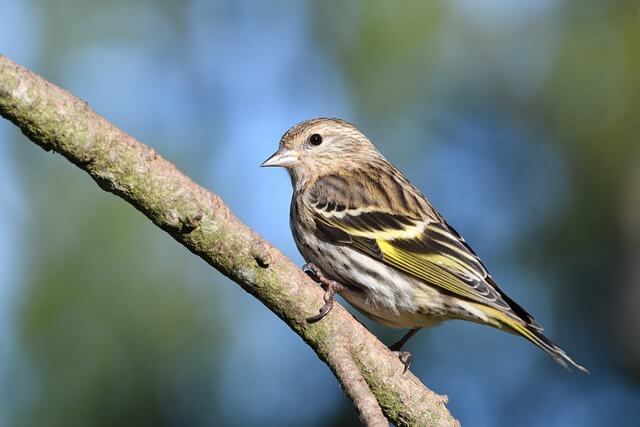
Pine Siskins are frequent winter guests in both Canada and the United States, with their range encompassing regions from southern Alaska down to the eastern edge of Colorado, and further extending eastward along the northern Great Plains to southern Manitoba.
These adaptable birds are widespread across Canada, making their home in all provinces and territories except Nunavut and the Northwest Territories. Pine Siskins have a diverse diet, predominantly feasting on seeds from various pine tree species, including white pine, loblolly pine, and longleaf pine, among others. In addition to seeds, they also incorporate insects like beetles and caterpillars into their diet.
Purple Finch

The Purple Finch, a petite avian species, calls the eastern United States and Canada its home. Its habitat spans from Southern Ontario to regions encompassing New York, Maine, Minnesota, and Montana. While these birds have a primary preference for pine cone seeds from various coniferous trees, including pines, spruces, firs, and hemlocks, their diet exhibits diversity.
In addition to pine cone seeds, they savor acorns, nuts, sunflower seeds, and a medley of berries such as blackberries and raspberries. When winter arrives, Purple Finches embark on migrations to seek out warmer climates.
Red-bellied Woodpecker

The Red-bellied Woodpecker is a medium-sized bird with a big personality. This species has been found in many parts of the United States, and can be seen as far north as Alaska. The largest populations are found in the southeastern states like Georgia and Florida.
The Red-bellied Woodpecker’s habitat is typically a deciduous forest, where they can find plenty of trees with cracks and crevices for nesting holes. The red-bellied woodpeckers have been known to eat pine cone seeds from Ponderosa pines, but they will also feed on insects, larvae, and eggs.
White-breasted Nuthatch
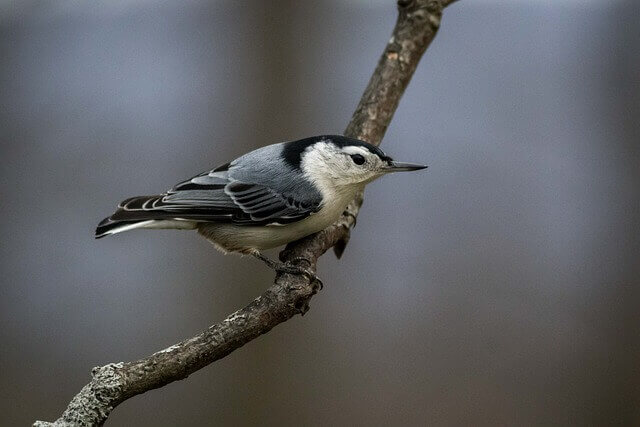
The White-breasted Nuthatch, characterized by its small, plump physique and distinctive black and white head stripes, thrives in North America’s coniferous forests. Its habitat spans from Alaska to Newfoundland and extends southward to Georgia, Arkansas, Kansas, and Iowa.
These charming birds predominantly inhabit mature or old-growth forests rich in evergreens. Their diverse diet includes insects, seeds, berries, and an abundance of pine cone seeds that flourish within these forested realms.
Red-breasted Nuthatch
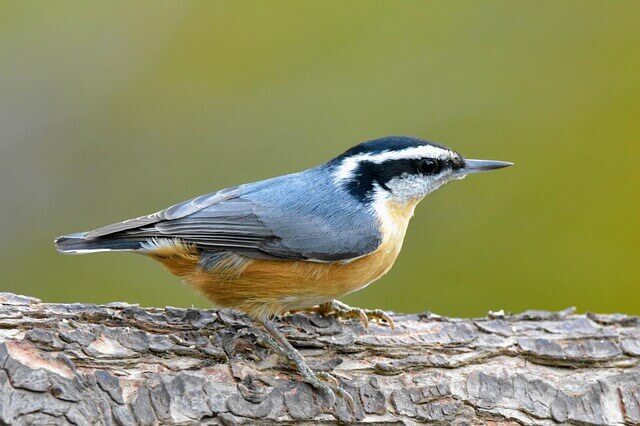
The Red-breasted Nuthatch is a small North American bird. Their diet consists mainly of insects, but it also includes seeds from coniferous trees, such as pine cones and spruce needles. The nuthatches are known for their habit of wedging themselves into the openings of trees to find food, often while upside down.
Nuthatches live in various types of forests across North America including spruce, fir, oak and mixed forest regions. They will also occasionally nest in urban areas such as parks and backyards. They can be found all year round throughout North America.
Behavior and Adaptations
Now that we’ve introduced you to the remarkable world of birds that feast on pine cones, let’s take a closer look at their fascinating behaviors and remarkable adaptations. These avian enthusiasts have developed specialized foraging techniques and physical traits that allow them to make the most of nature’s woody treasures.
1. Woodpecker Precision:
- Woodpeckers are renowned for their ability to cling to tree trunks and hammer away at pine cones with remarkable precision. Their strong beaks and sturdy tail feathers provide stability as they extract seeds with rhythmic pecking.
2. Nutcracker Mastery:
- Nutcrackers employ their powerful bills to crack open pine cones. Their long, pointed beaks allow them to access seeds deep within the cone’s chambers, showcasing their expertise in extracting these hidden treasures.
3. Nuthatch Nimbleness:
- Nuthatches are known for their agility as they traverse tree bark, often hanging upside down to reach pine cones. Their sharp bills enable them to expertly probe between cone scales, extracting seeds with precision.
4. Finch Finesse:
- Finches employ a delicate touch as they manipulate pine cones, extracting seeds with their dexterous bills. Their finesse and patience are remarkable, allowing them to access the nourishing seeds within.
5. Crossbill Specialization:
- Crossbills have a distinctive curved bill that is perfectly adapted for prying open tightly closed pine cones. Their unique beak shape allows them to access seeds that other birds might find challenging to reach.
6. Jay’s Versatility:
- Jays, known for their versatility, use their powerful beaks to both crack open pine cones and extract seeds. They are opportunistic feeders, making the most of available food sources.
These unique behaviors and adaptations demonstrate the incredible diversity and resourcefulness of these birds in their quest to enjoy the nutritious pine cone seeds. As we delve deeper into their world, we gain a deeper appreciation for their place in the intricate tapestry of nature.
Certainly, here’s a section on “Habitats and Distribution” that you can incorporate into your blog:
Habitats and Distribution
As we unravel the intriguing world of birds that indulge in pine cones, it’s crucial to understand where these feathered diners call home and how far their culinary adventures span. Their habitats and distribution shed light on the diverse landscapes they inhabit and whether they are migratory or year-round residents.
1. Pine-Clad Forests:
- Many of the pine cone-loving birds are intimately tied to coniferous forests. These evergreen havens provide the ideal backdrop for their foraging pursuits. Towering pines, spruces, and firs offer both sustenance and shelter.
2. Woodland Retreats:
- Beyond coniferous realms, you’ll find these birds in woodlands and mixed forests. They appreciate the variety of trees and shrubs, which often yield a diverse range of food sources.
3. Migratory Movements:
- Some of these birds, such as the Pine Siskin and Crossbill species, are known to be migratory. They embark on seasonal journeys in search of suitable pine cone-rich habitats. Their movements are guided by the availability of food.
4. Year-Round Residents:
- Others, like the resident White-breasted Nuthatch and local Nutcracker populations, prefer to stay in one region year-round. These birds have mastered the art of adapting to their chosen environments.
5. Geographic Range:
- The geographical distribution of these pine cone enthusiasts spans across North America, from the northern reaches of Alaska to the eastern expanses of Newfoundland. Their range extends southward to warmer climates, with some making their homes as far south as Georgia, Arkansas, Kansas, and Iowa.
Understanding their preferred habitats and distribution patterns helps us appreciate the breadth of their influence on the ecosystems they inhabit. Whether they are year-round residents or seasonal travelers, these birds play a vital role in shaping the natural world around them.
Ecological Significance
In the intricate tapestry of nature, these pine cone-loving birds hold a unique ecological significance. By indulging in these woody treasures, they inadvertently become stewards of their ecosystems, contributing in remarkable ways:
Seed Dispersal: As these birds extract and consume pine cone seeds, they inadvertently aid in seed dispersal. Some seeds escape the digestion process and find themselves scattered across the forest floor. This helps to distribute plant species and supports forest regeneration.
Forest Regeneration: Pine cones, often housing seeds, are integral to forest regeneration. When these birds feast on pine cones and disperse seeds, they play a pivotal role in ensuring the health and diversity of their forest habitats. Their actions contribute to the natural cycle of renewal.
Conservation Status
While some of these bird species may be thriving, it’s important to be aware of the conservation status of others. Conservation efforts play a crucial role in protecting their habitats and well-being. Here’s a brief overview:
Pine Siskin: This species is generally considered stable, but populations can fluctuate due to food availability and harsh winters.
White-winged Crossbill: Conservation status varies among subspecies, with some facing more significant threats due to habitat degradation.
Conclusion
In the world of nature, these 12 birds that dine on pine cones reveal the intricate balance of ecosystems. Their unique behaviors and habitats underscore the importance of biodiversity in our forests.
As we celebrate their roles in seed dispersal and forest regeneration, we’re reminded to protect and cherish these avian treasures. Nature’s wonders are endless, and the dining habits of these birds offer a glimpse into the complexity of our natural world.
References and Further Reading:
- Cornell Lab of Ornithology. (n.d.). Pine Siskin. Link
- National Audubon Society. (n.d.). White-winged Crossbill. Link
- Audubon Alaska. (n.d.). Red Crossbill. Link
- The Cornell Lab of Ornithology – Macaulay Library. (n.d.). Pine Cone Bird Feeder – Tufted Titmouse, White-breasted Nuthatch, Red-breasted Nuthatch, Northern Cardinal. Video Link
- Peterson, R. T., & Mountfort, G. (1991). A Field Guide to Western Birds. Houghton Mifflin Harcourt.
- Sibley, D. A. (2000). The Sibley Guide to Birds. Alfred A. Knopf.
- Peterson, R. T., & Mountfort, G. (1991). A Field Guide to Western Birds: This field guide, authored by Roger Tory Peterson and Guy Mountfort, provides detailed information on bird species found in western North America. It includes information on bird behavior, feeding habits, and habitat preferences. You can refer to this guide for specific information on birds that eat pine cones in the western region.
- Youtube video link of Crossbill eating pine cones.

